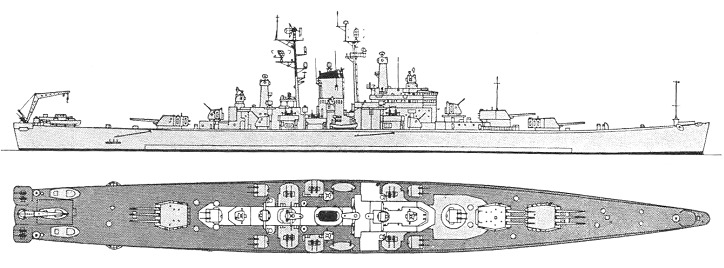
NAVYPEDIA
 Support the project with paypal
Support the project with paypal
Photo

Salem 1950
Ships
| No | Name | Yard No | Builder | Laid down | Launched | Comm | Fate |
|---|---|---|---|---|---|---|---|
| CA134 | Des Moines | 1571 | Bethlehem, Quincy | 28.5.1945 | 27.9.1946 | 17.11.1948 | stricken 7.1991 |
| CA139 | Salem | 1572 | Bethlehem, Quincy | 4.6.1945 | 25.3.1947 | 9.5.1949 | stricken 7.1991, preserved |
| CA140 | Dallas | 1573 | Bethlehem, Quincy | 1945? | --- | --- | cancelled 6.1946 |
| CA148 | Newport News | 456 | Newport News | 1.10.1945 | 6.3.1947 | 29.1.1949 | stricken 7.1978 |
Technical data
| Displacement standard, t | 17255 |
|---|---|
| Displacement full, t | 20934 |
| Length, m | 213.4 wl 218.4 oa |
| Breadth, m | 23.0 |
| Draught, m | 7.92 full load |
| No of shafts | 4 |
| Machinery | 4 sets General Electric geared steam turbines, 4 Babcock & Wilcox boilers |
| Power, h. p. | 120000 |
| Max speed, kts | 33 |
| Fuel, t | oil 3006 |
| Endurance, nm(kts) | 10500 (15) |
| Armour, mm | belt: 152 - 102, deck: 95, upper deck: 25, bulkheads: 127 - 102, barbettes: 160, turrets: face 203, roof 102, sides 95 - 51, rear 38, armoured bridge: 165 - 140 |
| Armament | 3 x 3 - 203/55 Mk 16, 6 x 2 - 127/38 Mk 32, 12 x 2 - 76/50 Mk 34, 12 x 2 - 20/70 Mk 24 |
| Electronic equipment | SG-6, SK-3, SPS-6, 2x Mk 13, 4x Mk 25, 4x Mk 35 radars |
| Complement | 1799 |
Standard scale images

Newport News 1963

Newport News 1949
Graphics
Project history
These three ships were the culmination of wartime US cruiser design. As soon as the Bureau of Ordnance perfected the automatic 152/47mm DP gun on which it had been working since 1937, it realised that the same principles could be applied to triple the rate of fire of the 203mm gun; detailed weight estimates for twin and triple turrets became available in July, 1943 and was almost immediately designed and ordered as the next class. Such weapons would overcome the great defect of existing 203mm guns: excessively slow fire, so slow that it was almost impossible to hit fast Japanese ships in night actions; at the same time they would greatly outrange the existing fast-firing 152mm guns. At first twin turrets were contemplated, on the theory that these ships might not even be delayed by the change; however, the General Board was already dissatisfied with existing heavy cruiser designs and fell that by demanding a completely new ship with triple turrets it would provide the post-war fleet with at least some satisfactory cruisers; otherwise the war might end with nothing but an inadequate six-gun ship under construction. New features not connected directly with new guns included a unit machinery arrangement similar to that in battleships and unique among US cruisers, and a separate 'bomb deck' to improve protection against bombing. Immune zone against 203mm shell was between 77 and 138 cables. As the decision to pass to a new class was made in mid-1943, the next cruisers to be ordered were CA139-142 and CL143-149. In October, 1943 CA134 was added to the new class (Des Moines) to bring it to five ships; the question was also asked whether CL143, 148 and 149 were shifted to the new heavy cruiser design, but CL144-147 were retained as units of a new 152mm DP cruiser class (Worcester) largely in order to ensure that some of the new twin DP 152/47mm mounts were sent to sea. A late-war (1945) programme, which would have added CA150-153, was never approved by the President, leaving, at the end of the war, eight prospective members of the Des Moines class. CA142, 143 and 149 were all suspended, although materials for them were held pending a decision as to their fate. Indeed, Admiral King argued strongly for their completion on the theory that a homogeneous group of eight such ships would be extremely valuable. However, he was overruled and later CA140 and 141, which were little advanced, were cancelled. The three ships completed appear to have been successful, Newport News serving as a flagship and fire support ship until she was decommissioned in 1975. The new 203mm rapid-fire gun appears to have worked well in service, the sole exception being a turret explosion in Newport News in 1972, which completely disabled No2 mount.
Ship protection
Main belt between end barbettes had 3.1m height. It was 152mm thick (102mm at lower edge). There were 6 127mm transverse bulkheads (2 outer and 4 inner), dividing the ship on 5 zones. Armoured deck over main belt was 95mm. Above was upper 25mm deck. Barbettes were 178mm thick. Turrets had 203mm faces, 90-51mm sides, 38mm rears and 102mm crowns. Armoured bridge had 165-140mm sides.
Modernizations
1952, all: - 12 x 2 - 20/70
1950s, all: - SK-3, SPS-6 radars; + SPS-6C, SPS-8 radars, SLR-2 ECM suite
1959, all: - 1 x 2 - 76/50
1960s, Salem: - SPS-6C radar; + SPS-12, 2x Mk 34 radars
1962, Des Moines: - 1 x 2 - 76/50
1970s, all: - SLR-2 ECM suite
Naval service
Newport News was badly damaged in 1972 by explosion of No 2 turret. Turret was fully demolished.
 HOME
HOME FIGHTING SHIPS OF THE WORLD
FIGHTING SHIPS OF THE WORLD UNITED STATES OF AMERICA
UNITED STATES OF AMERICA CRUISERS
CRUISERS DES MOINES heavy cruisers (1948 - 1949)
DES MOINES heavy cruisers (1948 - 1949)
